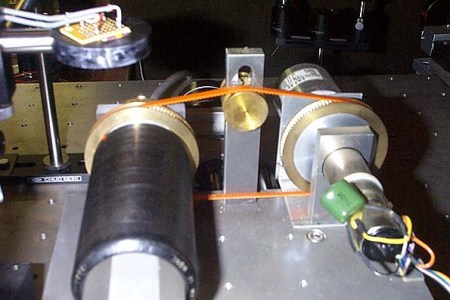
From 1902 to 1905, Polish anthropologist [Bronislow Pilsudski] did a series of recordings in Hokkaido japan on wax cylinders. Researchers at the university of Hokkaido have been working on ways to read the cylinders without causing any further damage to the grooves. Their preferred method has been to use reflected laser light. They have a very short writeup on their configuration, but it should be enough to get the idea.
Another project they’ve taken on is reading the original molds as well. They had to completely reconfigure their device to be able to be inserted into the cylinder. The quality they get from those is far superior though.















What about using silicone rubber to duplicate the wax cylinders? It will capture the detail without damaging the cylinders and then allow them to replicate them as many times as they wanted.
In fact, “modern” master records use a similar technique albeit with urethane / silver.
They probably use lasers because although a silicone rubber would duplicate the cylinders there is a chance that they could damage them, or the process of even making the castings, putting the rubber on, taking it off, all the handling, could cause damage, and these cylinders are one of a kind. Its kinda of the same reason they don’t photocopy the dead sea scrolls, the photocopying itself wouldn’t damage them, put the process of doing it would. And anyway lasers are cool!
For playing galvanos – cylinder moulds – the same basic method was used, but the equipment had to be built much more compactly to fit inside the copper tube. To accomplish this, the reflected beam had to take the same way out as it came in. The sound quality obtained from galvanos was much better than from wax cylinders. Cylinders have almost always been played many times, while galvanos are moulds made from pristine wax cylinders.
I think that even that might carry some chance of damage. The laser method should give an excellent end result without any chance of harming the original. It’s a very clever solution to the problem. You could make audio files of the results, or you could probably even use the data with some manner of 3d printer to make more physical copies of the cylinders, if the tech has progressed to the point where that’s possible.
Lol 3d print physical audio media would be cool
A recent post here featured a person who created audio media of of plastic with mill, I can’t see why a 3D printer couldn’t do the same.
they should get a higher wattage laser to obtain a cleaner, smoother, more ‘liquid’ sound. maybe even try it with a MegaWatt ;{
Not sure if trolling… or just brainwashed by the “purity” of oxygen free, diamond encrusted $2500 “analog only” cables.
High wattage, wax, liquid… can you connect the dots?
i guess i’m a trollin’, but where can i obtain such a cable?
Just one remark, the first name of the anthropologist is spelled Bronislaw, not with “o”.
http://en.wikipedia.org/wiki/Bronisław_Piłsudski
This idea goes back to pre CD times. The development of the lazer turntable could have been the way forward, the projected price of it went up and up. Then it disappeared and the CD came, now in the hands of the Japanese it finally exists. But too late.
Isn’t this problem solved? Just get together with these guys.
Tracking the groove would be far easier by mounting the laser and detector to an original Edison cylinder player/recorder, or by duplicating the drive mechanism of one.
That would easily take care of matching the groove pitch and combining old wood, brass and nickel with modern electronics would have it looking quite steampunk. ;)
The ELP Laser Turntable system wouldn’t be easy to adapt to cylinder recordings because they (and Edison’s discs) were vertically recorded. The stylus moves up and down instead of sideways.
Let’s see a DIY laser turntable for 45 RPM and LP records. That would be a super hack!
Here’s another effort at non-contact reading of records and cylinders. http://irene.lbl.gov/
This is cool!
Has anyone seen a similar technique where they got market place sounds from Greek or Roman or Egyptian pottery?
As the potter was smoothing off the outside of urns or pots it left faint sounds.
You can sorta hear someone talking and the sounds of a blacksmith beating something as well.
http://www.museumofhoaxes.com/hoax/weblog/comments/3992/
The ancient recordings in pottery were an april fools hoax..
this could be a way to preserve history safely
The episode of Call for Help where they were looking at the wax cylinder… Classic.
http://www.youtube.com/watch?v=pnsizkVjGm8